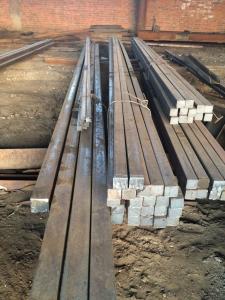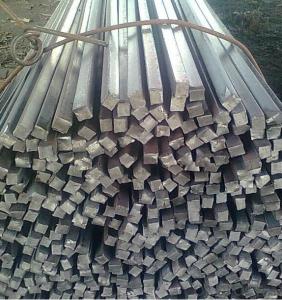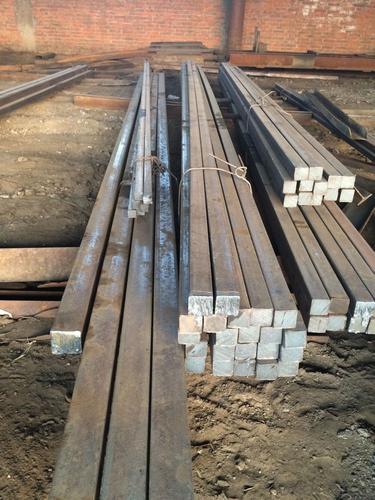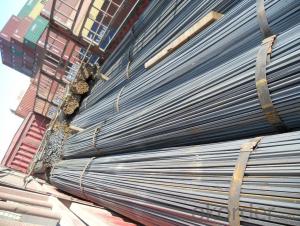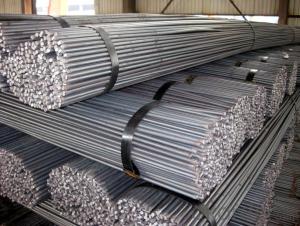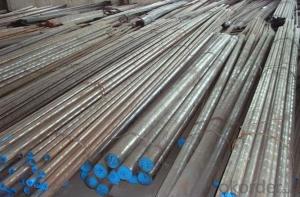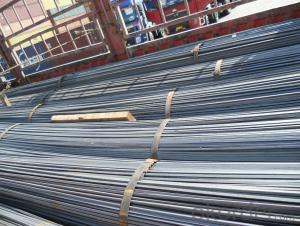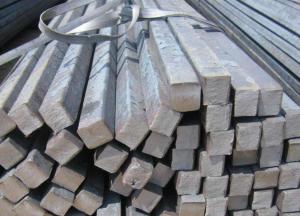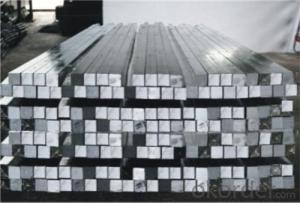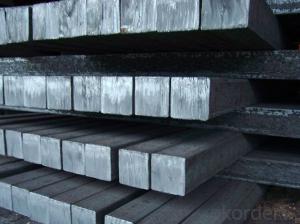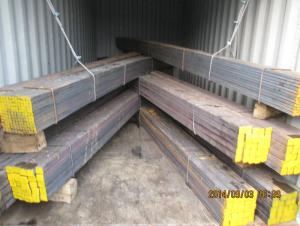Hot Rolled Steel Square Bar Q235, A36 SS400
- Loading Port:
- China main port
- Payment Terms:
- TT or LC
- Min Order Qty:
- 25 m.t.
- Supply Capability:
- 200000 m.t./month
OKorder Service Pledge
OKorder Financial Service
You Might Also Like
Product Description:
OKorder is offering Hot Rolled Steel Square Bar Q235, A36 SS400 at great prices with worldwide shipping. Our supplier is a world-class manufacturer of steel, with our products utilized the world over. OKorder annually supplies products to European, North American and Asian markets. We provide quotations within 24 hours of receiving an inquiry and guarantee competitive prices.
Product Applications:
High Qualty Hot Rolled Steel Square Bar Q235, A36 SS400 are ideal for structural applications and are widely used in the construction of buildings and bridges, and the manufacturing, petrochemical, and transportation industries.
Product Advantages:
OKorder's Hot Rolled Steel Square Bar Q235, A36 SS400 are durable, strong, and resist corrosion.
Main Product Features:
· Premium quality
· Prompt delivery & seaworthy packing (30 days after receiving deposit)
· Corrosion resistance
· Can be recycled and reused
· Mill test certification
· Professional Service
· Competitive pricing
Product Description:
Specifications of Q235, A36 High Qualty Hot Rolled Steel Square Bar :
-Standard: GB,
-Grade: Q195/Q235 or equivalent.
-Chemical Composition:
Standard | Grade | Element (%) | ||||
C | Mn | S | P | Si | ||
GB | Q195 | 0.06~0.12 | 0.25~0.50 | ≤0.050 | ≤0.045 | ≤0.30 |
GB | Q235B | 0.12~0.20 | 0.30~0.70 | ≤0.045 | ≤0.045 | ≤0.30 |
-Mechanical Properties:
Mechanical Properties | Grade | Steel diameter(mm) | |||
≤16 | 16~40 | 40~60 | 60~100 | ||
Yield Point Δs/MPa | Q195 | ≥195 | ≥185 | - | - |
Q235 | 235 | 225 | 215 | 205 | |
Tensile Strength | Q195 | 315~390 | |||
Q235 | 375~500 | ||||
Elongation δ5% | Q195 | ≥33 | ≥32 | - | - |
Q235 | 26 | 25 | 24 | 23 | |
Measures of High Qualty Hot Rolled Steel Square Bar GB, ASTM, JIS Standard:
-Length of a side and Theoretical weight of Square Bar (Big measures).
Length of a side(mm) | Theoretical weight(kg/m) | Length of a side(mm) | Theoretical weight(kg/m) |
53 | 22.05 | 80 | 50.24 |
56 | 24.61 | 85 | 56.72 |
60 | 28.26 | 90 | 63.59 |
63 | 31.16 | 95 | 70.85 |
70 | 38.49 | 100 | 78.50 |
75 | 44.16 |
Notes:
1, The theoretical weights in the list, base on the density of 7.85 g/cm3.
2, Formula for theoretical weight of Square bar: a(length of a side) * a * 0.00785
3, The numbers with *mean that they are not regular or we don’t offer them.
-Regular length of Square Bar:
Steel | Length of a side (mm) | Length of steel (m) |
Normal steel | < 25 | 4~10 |
> 25 | 3~9 | |
Steel of high quality | All measure | 2~6 |
Tool steel >75 | 1~6 |
Usage/Applications of High Qualty Hot Rolled Steel Square Bar GB, ASTM, JIS Standard:
-The Square Steel is normally used as structure steel.
-Row material for other structure steel like steel angles, channels, I-beams, H-beams, etc…
-Row material for steel pipes.
Packaging & Delivery of High Qualty Hot Rolled Steel Square Bar GB, ASTM, JIS Standard:
-Packing Detail:
1, The products can be packed in bundles by steel wires.
2, The weight of each bundle no exceed normally 3 tons.
-Marks: We make tag marks and color marks for each bundle. The tag marks with white background and red company log will be tied up to each bundle. The information is usually including basic information of company and products like product name, specification, etc...and other information required by customers. As for color marks, we will paint both ends of each bundles to make sure that it will be more convenient for customers to distinguish theme from other products.
-Delivery Detail: 30~45 working days after receive buyer’s T.T. or L/C.
Payment:
-Invoicing on theoretical weight or actual weight as customer’s request.
-FOB, CFR or CIF.
-Regular terms of payment:
1, 30% payment in advance, the remaining balance (70% payment) against the copy of B/L.
2, 30% payment in advance, the remaining balance (70% L/C) against the copy of B/L.
3, Negotiable.
-The payment terms will be written in contraction detailedly.
We sincerely welcome partners around the world to establish business cooperation with us on the basis of mutual trust, benefit and development.
FAQ:
Q1: Why buy Materials & Equipment from OKorder.com?
A1: All products offered byOKorder.com are carefully selected from China's most reliable manufacturing enterprises. Through its ISO certifications, OKorder.com adheres to the highest standards and a commitment to supply chain safety and customer satisfaction.
Q2: What makes stainless steel stainless?
A2: Stainless steel must contain at least 10.5 % chromium. It is this element that reacts with the oxygen in the air to form a complex chrome-oxide surface layer that is invisible but strong enough to prevent further oxygen from "staining" (rusting) the surface. Higher levels of chromium and the addition of other alloying elements such as nickel and molybdenum enhance this surface layer and improve the corrosion resistance of the stainless material.
Q3: Can stainless steel rust?
A3: Stainless does not "rust" as you think of regular steel rusting with a red oxide on the surface that flakes off. If you see red rust it is probably due to some iron particles that have contaminated the surface of the stainless steel and it is these iron particles that are rusting. Look at the source of the rusting and see if you can remove it from the surface.
Images:
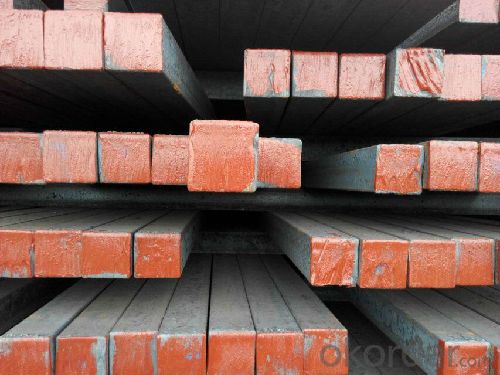

- Q: What are the different techniques for using a steel square in welding?
- One technique for using a steel square in welding is to use it as a guide for making accurate 90-degree angles. This can be done by placing the square against the materials being welded and ensuring that the edges align perfectly. Another technique is to use the square as a measuring tool, allowing the welder to accurately measure and mark distances on the materials. Additionally, the steel square can be used as a straight edge for ensuring straight and even welds. Overall, the steel square is a versatile tool that helps welders achieve precision and accuracy in their work.
- Q: Can a steel square be used for measuring angles in tile work?
- Yes, a steel square can be used for measuring angles in tile work. Steel squares, also known as framing squares or carpenter squares, are versatile tools commonly used in construction and woodworking. They have a 90-degree angle and a straight edge that can be used to measure and mark angles accurately. While a steel square may not provide precise measurements for more complex angles, it is suitable for measuring and marking 90-degree angles, which are commonly used in tile work. Additionally, steel squares are durable and easy to use, making them a practical choice for tile installation projects.
- Q: Can a steel square be used for drywall patching?
- Yes, a steel square can be used for drywall patching. It can be used to measure and mark the dimensions of the patch accurately, ensuring a precise fit. Additionally, the straight edge of a steel square can be used as a guide for cutting the drywall patch.
- Q: Can a steel square be used for measuring the height of a building?
- No, a steel square cannot be used for accurately measuring the height of a building. A steel square, also known as a framing square, is a right-angled measuring tool commonly used in carpentry and woodworking. It consists of two arms, one shorter and one longer, joined together at a 90-degree angle. While a steel square is useful for measuring and marking angles, it is not designed for measuring vertical distances. To measure the height of a building, specialized tools such as a laser level, a theodolite, or a total station would be more appropriate. These instruments are specifically designed for measuring vertical heights and can provide precise and accurate results. They use various techniques, such as lasers or optical measurements, to determine the height of a building by measuring the angle of elevation or by directly measuring the distance from the base to the top. In conclusion, while a steel square is a versatile tool for certain construction and woodworking tasks, it is not suitable for measuring the height of a building. Using the appropriate instruments designed for this purpose will ensure accurate measurements.
- Q: How do you use a steel square to determine the angle of a beading cut?
- To use a steel square to determine the angle of a beading cut, you first need to understand the markings and measurements on the square. A steel square typically has two arms, one longer than the other, joined at a 90-degree angle. The longer arm is called the blade, while the shorter one is the tongue. To determine the angle of a beading cut, follow these steps: 1. Place the blade of the steel square against the surface from which you'll be making the cut. Ensure the blade is flush with the edge of the material. 2. Hold the square firmly in place, making sure it doesn't move during the process. 3. Observe the markings on the tongue of the square. The most common steel squares have markings in degrees and fractions of an inch. 4. Look for the degree measurements and find the one closest to the desired angle for your beading cut. 5. Once you've identified the closest degree measurement, use a pencil or marker to mark that angle on the material. 6. Carefully remove the steel square, ensuring that the marked angle remains visible on the material. 7. Use a straight edge or a ruler to connect the marked angle with the desired length of the beading cut. 8. Double-check your measurements and angles before proceeding with the cut. 9. If you have a power tool, such as a miter saw or circular saw, set the blade to the desired angle and make the cut. 10. If you're making the cut manually, use a coping saw or a hand saw to carefully follow the marked angle and make the beading cut. Remember to always prioritize safety when working with tools and machinery. Double-check your measurements, wear appropriate safety gear, and work in a well-ventilated area.
- Q: Can a steel square be used for measuring the height of a flag?
- Yes, a steel square can be used for measuring the height of a flag. A steel square is a versatile measuring tool that can be used for various purposes including measuring angles, distances, and heights. To measure the height of a flag, one can hold the steel square vertically against the flagpole and align it with the top of the flag. By reading the measurement scale on the square, the height of the flag can be determined accurately. However, it is important to ensure that the steel square is held perpendicular to the ground and that the flag is not swaying or moving excessively to obtain an accurate measurement.
- Q: Can a steel square be used for layout work?
- Layout work can indeed make use of a steel square. Known as combination squares, these versatile tools find frequent application in woodworking and metalworking for the purpose of angle measurement, squareness checking, and straight line marking. Typically, one edge of the square forms a 90-degree angle, while the head can be adjusted or slid to accurately measure and mark angles other than 90 degrees. With its steel construction, this square guarantees durability and precision, rendering it a dependable tool for layout work.
- Q: Can a steel square be used for checking the levelness of floors?
- No, a steel square is not typically used for checking the levelness of floors. It is primarily used for measuring, marking, and checking right angles in woodworking and carpentry. For checking the levelness of floors, a level or a laser level would be more appropriate tools.
- Q: Can a steel square be used for measuring curved surfaces?
- A steel square is not capable of measuring curved surfaces. It is specifically designed for measuring and marking straight lines and right angles. It is composed of a long blade and a shorter tongue that are perpendicular to one another. The straight edges of a steel square make it perfect for tasks like checking corner squareness or marking 90-degree angles. However, its inflexible shape renders it unsuitable for measuring or marking curved surfaces. To measure curves, it would be more suitable to use flexible measuring tools like a flexible tape measure or a contour gauge.
- Q: How do you use a steel square to check for levelness?
- To use a steel square to check for levelness, you would first start by placing the square on the surface you want to check. Ensure that the square is positioned firmly and evenly on the surface. Next, observe the bubble level on the square. The bubble level is typically located in the center of the square. It is a small glass tube with a liquid and an air bubble inside. The bubble should be between two marked lines or in the center of the tube if it is a digital level. If the bubble is centered between the lines or in the middle of the tube, it indicates that the surface is level horizontally. If the bubble is not centered and leans towards one side, it means the surface is not level and needs adjustment. To level the surface, you can use shims or adjust the legs or supports under the surface until the bubble is centered. You can also use the square as a guide to measure the difference in height or levelness across different points of the surface. Keep in mind that a steel square is typically used for smaller, more precise leveling tasks. For larger surfaces or more accurate measurements, a longer level or laser level might be more appropriate.
Send your message to us
Hot Rolled Steel Square Bar Q235, A36 SS400
- Loading Port:
- China main port
- Payment Terms:
- TT or LC
- Min Order Qty:
- 25 m.t.
- Supply Capability:
- 200000 m.t./month
OKorder Service Pledge
OKorder Financial Service
Similar products
Hot products
Hot Searches
Related keywords
